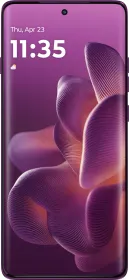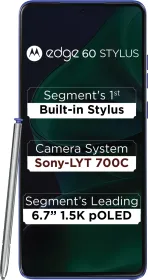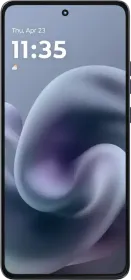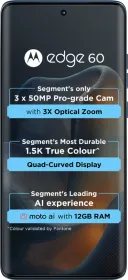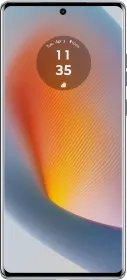The Motorola Edge 50 Fusion was a standout success, selling impressively well for the brand. It brought a lot to the table, a Snapdragon 7s Gen 2 processor, good cameras, an OLED display, decent battery life, and more. Now, Motorola is back with the Edge 60 Fusion, which keeps the same camera setup but steps things up in a few key areas.
These upgrades include improved water and dust protection, a higher-resolution display, a better selfie camera with a larger aperture, and a bigger battery. Plus, it’s packed with new AI features, making that another highlight to explore.
So, how does the Edge 60 Fusion hold up in real-world use? Let’s take a closer look at its performance, cameras, and everything else it has to offer.
Motorola Edge 60 Fusion Price & Availability
The Motorola Edge 60 Fusion arrives in Pantone-curated Greyish Purple, Cyan, and Pink, featuring a vegan leather finish. It’s available via Flipkart, motorola.in, and leading retail stores. The Edge 60 Fusion is available in the following RAM and storage options.
- 8GB + 256GB: ₹22,999
- 12GB + 256GB: ₹24,999
Pros
- Beautiful design with premium vegan leather
- Bright, colorful 1.5K pOLED display
- Great durability (IP68+IP69, MIL-810H)
- Decent battery life
- Good AI feature set with moto AI
Cons
- Display isn’t truly quad-curved as advertised
- Mediocre gaming performance
- Image oversharpening issue
- Videos are recorded in Rec601
- Weather app is filled with ads
- Camera app can feel slow at times
Motorola Edge 60 Fusion Specifications
- Display: 6.7-inch pOLED, 1.5K (1220p), 446 PPI, 120 Hz, 4500 Nits peak, 1400 Nits HBM, 100% DCI-P3, 10-bit, Pantone Validated, Gorilla Glass 7i
- SoC: MediaTek Dimensity 7400 (TSMC 4nm)
- RAM: 8GB / 12GB LPDDR4X
- Storage: 256GB UFS 2.2
- Main Camera: 50 MP Sony LYT-700C, 1/1.56-inch, f/1.8, OIS, AF, 24mm, 4K30/60
- Ultra-wide Camera: 13MP, 1/3-inch, f/2.2, 120°, AF, 12mm, 4K30
- Front Camera: 32MP, 1/3-inch, f/2.2, 27mm, 4K30
- Speakers: Stereo
- Battery and Charging: 5,500 mAh, 68W Turbo Charging
- IP Rating: IP68 + IP69
- Connectivity: 5G, Wi-Fi 6, Bluetooth 5.3, USB 2.0
- Biometrics: In-display fingerprint, 2D face unlock
- Weight and Thickness: 180g, 8.2mm
- Build: Vegan leather back, military-grade certification (MIL-810H)
Motorola Edge 60 Fusion Review: Unboxing

Opening the Motorola Edge 60 Fusion box reveals a thoughtfully eco-friendly package—plastic-free, made with 80% recycled materials, and a 100% compostable insert printed with soybean ink. Inside, you’ll find:
- Motorola Edge 60 Fusion
- 68W Turbo Charger
- USB-C to USB-C cable
- SIM ejector tool
- Paperwork
It’s a standard unboxing experience, but Motorola isn’t including a case this time around. There is no pre-applied screen protector either.
Motorola Edge 60 Fusion Review: Design and Build

Motorola is doubling down on its “lifestyle-tech” identity, and the Edge 60 Fusion is a prime example. It’s available in Pantone-curated colors—Amazonite, Flipstream, and Zephyr (a soft pink shade)—with a soft-touch vegan leather back that feels premium.
The phone is 8.2 mm thick and lightweight at 180g, and its military-grade MIL-STD-810H certification, paired with IP68 and IP69 water and dust resistance, makes it one of the most durable options in its segment.

The design emphasizes “all-curved comfort,” with edges that Motorola claims are the “world’s first true all-curved display.” However, this is a stretch—more on that in the Display section. The sides are deeply curved (around 45 degrees), which is both a Pro and a con.
The bezels are slim, and the Motorola logo sits at the center of the back panel. The camera module houses a 50MP + 13MP setup, along with a 3-in-1 ambient light sensor, and there’s some branding on the dummy camera ring.

The right side has power and volume buttons, which are comfortable but could have been positioned slightly lower. The left side is clean. The bottom features a USB-C port, a hybrid SIM card slot, the primary microphone, and a speaker. Up top, there’s another microphone and Dolby Atmos branding. Interestingly, there’s an additional microphone on the right side as well.
In-hand feel is excellent, with the leather texture resisting smudges better than glass or plastic. However, long-term durability of vegan leather remains a concern. The steep side curves also feel excessive at times, especially during gaming. The display is prone to scratches, so a screen protector is a must (there’s none pre-applied).
Motorola Edge 60 Fusion Review: Display

Motorola calls this a “true all-curve” display, but that’s a bit of a stretch. The 6.7-inch, 1.5K (1220p) panel has extreme side curves (45-degrees), almost too much, making it feel less practical. The top and bottom aren’t curved; only the bezels have a slight curve, so it’s not a true quad-curve screen.
Pantone Validation is here, meaning colors are tuned for accuracy, but out of the box, the display leans warm with “Natural” as the default color profile. You can switch to “Vivid” if you prefer punchier colors with a cooler tone.
Brightness is impressive, with 4500 Nits peak and 1400 Nits HBM. But here’s the catch—Netflix doesn’t support HDR, making that peak brightness feel wasted. YouTube HDR works fine, though, and the 10-bit color with 100% DCI-P3 gamut ensures a solid visual experience. The outdoor visibility is also great.

The 120 Hz refresh rate is smooth, but in Auto mode, most apps run at 90 Hz or 60 Hz unless you manually switch to 120 Hz. PWM dimming is on the higher side (likely 1920Hz+), making it easier on the eyes. We tested it, and flicker was acceptable even at 20% brightness, though it got worse below 10%.
Touch response is snappy, and overall, the display quality is good—just be prepared for those extreme curves. Finding a screen protector will be difficult, especially since this has a curved screen.
Motorola Edge 60 Fusion Review: Speakers and Haptics

The speakers on the Motorola Edge 60 Fusion are decent but nothing extraordinary. Stereo separation isn’t great, and while loudness is acceptable, it could have been better. There’s noticeable distortion at higher volumes, but for the price, it stays within an acceptable range.
Haptics are not the cheap “spring” type—you feel them more than you hear them. They aren’t flagship-level strong, but the integration is decent. You get feedback when unlocking with the fingerprint scanner, tapping and holding apps or notifications, and pulling up the app drawer.
However, there’s no haptic feedback when pulling down the notification center, locking/unlocking (unless via fingerprint), taking screenshots, or adjusting volume and brightness—even in the split-style control center.
Motorola Edge 60 Fusion Review: Software

Motorola’s Hello UI, based on Android 15, brings a mix of customization, AI features, and some questionable choices. The control center now has two styles—the classic one and a new split design that separates notifications from quick settings. If you prefer a cleaner layout, the new one might work for you.
The highlight here is the fluidity, but there’s a catch. Animations are linear, and there’s no wallpaper scaling or blur, which isn’t surprising. But what’s odd is the lack of animation when pulling down the new control center.

The same applies to the app drawer—just a static transition. On the plus side, blur is present across the UI, giving it a polished look, but if that’s not your thing, you can disable it from the developer options.
Bloatware is still a thing, though not excessive. The weather app has ads, which feels unnecessary, and there are a few pre-installed apps, but thankfully, you can uninstall them. There’s no intrusive app store to deal with, which is a relief.
The media player in the control center, however, feels out of place—it’s oddly narrow and looks unfinished. The always-on display is here as well, showing the time, date, and notifications at a glance. It matches the lock screen clock.
Moto AI

Motorola has gone big on AI, and the Edge 60 Fusion brings a set of intelligent features that integrate directly into the UI. Circle to Search is here, allowing you to circle any part of your screen to instantly look up information. Screen Translate and Music Search are also available with it.
Google Gemini and Gemini Live are fully supported, which means you get a built-in AI assistant for various tasks. The Photos app includes Magic Editor and Magic Eraser, but these are the usual Google Photos tools you’d find on most Android devices.
The real highlight is Moto AI’s exclusive features. Catch Me Up compiles a summary of all the important notifications you’ve missed, making it easier to stay updated. However, I didn’t find the feature very useful since it does not summarize any dismissed notifications.

Plus, it only seems to summarize a few notifications and ignore the rest. You can access previous summaries (history) by going to the History tab.
Pay Attention is also integrated into the app drawer’s search bar, allowing you to dictate notes or type queries directly. If you use the Take Notes feature, you can instantly start voice recording, and once you’re done, the AI will transcribe it and generate a summary.

Another useful tool is Remember This. You can take a photo, save a note, or capture a screenshot, so later, if you need to recall anything, you can ask Moto AI, and it will find it for you. Again, this feature has a lot of friction since I need to type a tag before saving the photo or the screenshot.

Magic Canvas is another AI feature, letting you generate images using AI. The resolution is a bit low, but the option is there. Style Sync is also available, generating wallpapers and themes based on your outfit or style preferences.

Updates and Additional Features

Motorola is promising three years of OS updates and four years of security patches, which is the industry standard at this point. Hello UI looks polished, with extensive theming options and a clean interface, but it could have been smoother.
There are occasional slowdowns that take away from the experience, though a future update might address that. The software includes features like Photo Unblur, Portrait Blur, and Sky Color Blur, but these are all part of the Google Photos suite and not exclusive to Motorola.
The RAM Boost feature is here as well, expanding virtual RAM, though in practice, it tends to slow the phone down rather than improve performance. Therefore, I would recommend you keep it disabled.
Customization is a major focus, with options for custom fonts, colors, and icons. Moto Secure 5.0 provides privacy tools, while Moto Connect and Smart Connect allow seamless integration with a PC.
You can stream your phone’s screen, transfer files, use a universal clipboard, and even turn your phone into a webcam. Family Space adds parental controls and remote assistance options, making it easier to manage multiple devices. Moto Unplug is also included, offering a way to minimize distractions by limiting certain functionalities.
Motorola has packed a lot into Hello UI, balancing useful tools with a few unnecessary extras. While the AI integration is impressive, the overall performance could use some refinement. The software has potential, but a smoother experience would make it feel more complete.
Motorola Edge 60 Fusion Review: Biometrics

The in-display fingerprint scanner is fast and reliable, but positioned quite low. The 2D face unlock works well in good lighting but isn’t as secure. No complaints here—biometrics match segment expectations.

Motorola Edge 60 Fusion Review: Performance
Powered by the MediaTek Dimensity 7400 (4nm), with 8 GB or 12 GB LPDDR4X RAM and 256GB UFS 2.2 storage, the Edge 60 Fusion is a mid-tier performer. RAM Boost 4.0 extends virtual RAM, but it’s merely a gimmick. Here’s how it stacks up:

Synthetic Benchmarks
- AnTuTu v10: 682,953
- Storage Score: 57,878 (Sequential Read: 866MB/s, Write: 849MB/s)
- Geekbench 6: 1045 (single-core), 3013 (multi-core)
- OpenCL: 3149
- Vulkan: 3109
- 3DMark Wild Life Extreme: 1023 (6.13 FPS avg)
- Wild Life Extreme Stress Test: 1019 (best loop), 1001 (lowest loop), 98.2% stability
Thermals stay in check during benchmarks, peaking at ~40°C, which is commendable.

Gaming Performance
Gaming is where the Edge 60 Fusion stumbles. For BGMI, it’s locked at 60 FPS, averaging 58.7 FPS with stable temps (34°C). However, rivals with the Dimensity 7300 (e.g., CMF Phone 1) hit 90 or 120 FPS—Motorola’s optimization lags here.
In Genshin Impact, it’s capped at 30 FPS at every graphics setting, averaging 29.4 FPS with controlled temps (38°C), but the 60 FPS setting is unavailable, unlike competitors.

The steep curved edges exacerbate the issue—holding the phone feels awkward, and accidental touches disrupt gameplay. It’s fine for casual gaming like Clash of Clans, but serious gamers will find it lacking.
Motorola Edge 60 Fusion Review: Cameras

The Motorola Edge 60 Fusion sticks to the same camera setup as its predecessor but with a few tweaks. It now includes a 3-in-1 ambient light sensor, which is supposed to improve white balance (though, in my experience, it didn’t work that well).
The main camera now has an f/1.8 aperture instead of f/1.9, and the selfie camera also gets an upgrade, moving from f/2.5 to f/2.2. Everything else remains unchanged. Now, let’s talk about real-world performance.
Main Camera
In daylight, the 50 MP camera tends to oversharpen details—you can tell immediately. It’s my biggest issue with the images. HDR is fine, and details are sharp (but often too sharp). If you use the natural mode, it does manage to get white balance right about 50% of the time.











However, you won’t see the processing in the viewfinder—it only kicks in after the image is taken. The camera app itself feels a bit slow and laggy, and the Edge 60 Fusion takes noticeable time to process photos. The 2X crop follows the same story, and at 4X zoom, there’s a significant loss in detail.
Low-light performance is a mixed bag. Noise control is handled well, but the details take a hit, and oversharpening is still there. It’s something Motorola really needs to refine. The large sensor has potential, but it doesn’t feel fully utilized.








Portrait Mode
The portrait mode offers three focal lengths—24mm, 35mm, and 50mm—all from the main camera. The results are decent, but not great. In good lighting, edge detection is acceptable, and semantic segmentation does a fair job.





However, finer details like hair strands often get blurred out. Any movement from the subject can mess things up, and the excessive sharpening makes skin textures look unnatural. There’s also a high-contrast effect on skin tones, which some might not like.
Ultrawide Camera
The 13 MP ultrawide camera has an f/2.2 aperture and a 1/3-inch sensor. It delivers decent results, but the over-sharpening issue persists. On the bright side, HDR is impressive, and if Motorola could tone down the sharpening, it could produce solid ultrawide shots. However, the edges of the frame do get a bit soft.


The ultrawide camera also doubles as a macro shooter, but the results aren’t particularly impressive. It lets you get close, but the lack of depth makes macro shots feel flat. You can use the 2X crop for a pseudo-macro effect.






Low-light ultrawide performance is average. While noise control is decent, a lot of detail is lost in the process. Still, considering most phones in this price range come with an 8 MP ultrawide, the Edge 60 Fusion does have an advantage. That said, color consistency between the main and ultrawide cameras isn’t great, and it’s something Motorola could improve.


Selfies
The selfie camera has a 32 MP sensor with a 27mm focal length (you can digitally crop to 50mm too) and an f/2.2 aperture. It captures good details, and produces fairly accurate skin tones but is inconsistent. Low-light selfies are slightly soft but acceptable. However, the narrow field of view makes group selfies tricky.


Portrait mode on the front camera is decent but edge detection may struggle, and HDR performance is inconsistent. Still, for its segment, selfie quality is acceptable.


Video Recording
The main camera supports 4K at 30fps and 60fps, with stabilization. The footage looks fine, but color reproduction is questionable—it uses Rec.601, an outdated color space from over a decade ago (Samsung used it back in the Galaxy S4 days). It’s odd that Motorola is still using this.
Ultrawide video performance isn’t up to the mark. You can shoot at 4K 30fps or 1080p, but there’s no 60fps option. Lens switching is abrupt—there’s no smooth transition, just a blank frame before it jumps to the next lens.
Selfie videos are also jittery and could use better color processing. The details are decent, and you can record in 4K 30fps, but overall, video performance feels like an afterthought.
Motorola Edge 60 Fusion Review: Battery Life and Charging

The Motorola Edge 60 Fusion packs a 5,500 mAh battery, delivering around 6 to 7 hours of screen-on time with typical usage. Battery life is solid, easily lasting a full day. It supports 68W fast charging, taking approximately 42 minutes for a full charge.
Review Verdict: Should You Buy the Motorola Edge 60 Fusion?
The Motorola Edge 60 Fusion refines its predecessor’s formula with a higher-resolution display, better durability, and a more AI software experience. Its design is premium, the display is bright and color-accurate, and the cameras deliver solid results—though oversharpening and video hold them back.
Performance is decent for everyday use, but gaming isn’t its strong suit. The software brings useful AI features, yet occasional slowdowns and bloatware (including ads in the Weather app) dampen the experience.
For its price, the Edge 60 Fusion stands out with its premium build, reliable battery life, and AI extras. However, if gaming or a truly curved display is your priority, you might want to look elsewhere.

Smartprix ⭐ Rating: 7.7/10
- Design and Build: 8.8/10
- Display: 8.2/10
- Speakers: 7.2/10
- Software:8.3/10
- Haptics: 7.8/10
- Biometrics: 8.5/10
- Performance: 7/10
- Cameras: 7/10
- Battery Life & Charging: 8.7/10
First reviewed in April 2025.

















